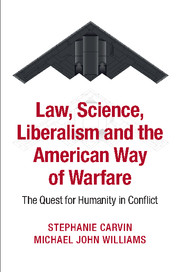Book contents
- Frontmatter
- Contents
- Prologue
- Introduction
- 1 Law and science in the Western way of war
- 2 The American way of war
- 3 Vietnam and the “science” of war
- 4 Immaculate destruction: reorganization, revolution and re-enchantment of War
- 5 Revolution denied: the “war” on terror
- 6 Back to the future?
- Index
- References
Introduction
Published online by Cambridge University Press: 05 December 2014
- Frontmatter
- Contents
- Prologue
- Introduction
- 1 Law and science in the Western way of war
- 2 The American way of war
- 3 Vietnam and the “science” of war
- 4 Immaculate destruction: reorganization, revolution and re-enchantment of War
- 5 Revolution denied: the “war” on terror
- 6 Back to the future?
- Index
- References
Summary
Between annihilation and restraint
If we are to learn from the past then history must first be understood on its own terms. One general point worth emphasizing [is], namely that each society and culture tends to have a unique view of warfare which affects how they fight and as a result how they may be beaten.
Adrian Goldsworthy, The Fall of CarthageSince its foundation as a republic in the eighteenth century, the United States has faced two broad imperatives: to be an example of liberty to the world and to maintain this role and protect itself by achieving absolute security. How the United States tries to balance these imperatives and the resulting tensions, particularly when it is engaged in armed conflict or perceives an immediate threat, is the purpose of this book.
We argue that the United States has often relied on science, especially applied science, to reconcile these two ends. As Auguste Comte wrote, “from science comes prevision, from prevision comes control.” Taking this maxim to heart, science has been seen as the key to controlling war, allowing the United States to achieve overwhelming and quick military victories, which are nevertheless relatively humane and worthy of its core liberal values. This is a reflection of America’s Enlightenment roots, with its faith in rationality and science to solve complex problems through understanding the natural world.
- Type
- Chapter
- Information
- Law, Science, Liberalism and the American Way of WarfareThe Quest for Humanity in Conflict, pp. 1 - 20Publisher: Cambridge University PressPrint publication year: 2014



